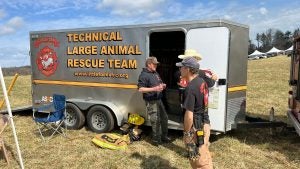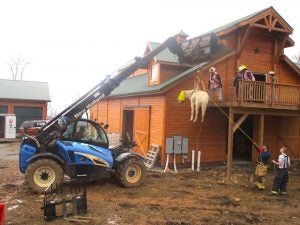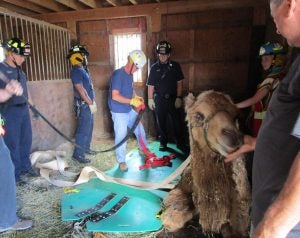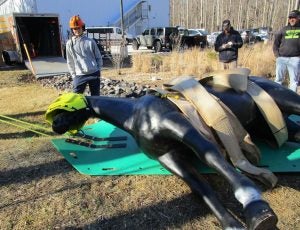Cattle stuck in pools. Horses in hay lofts. Calves in wells. Carrot-eating camels stuck in the stall. These are not the most recent viral videos on TikTok, they’re real-life incidents and rescue stories from the Little Fork Volunteer Fire & Rescue Company’s Technical Large Animal Rescue Team (TLAER). For these first responders in Virginia, these incidents are all in a year’s work — or, more technically, in a dozen years’ of work.
Halloween 2011 was when the group went on its first call as an official unit of the rescue company. The call was for a cow in a pool. When they arrived at the scene, there were already reporters, a helicopter, and a vet there. The vet was the only one Chief Doug Monaco said he felt relieved to see.
The rescuers used panels in the pool to contain the cow to a certain area, attached a Becker sling to the animal, and used a tractor to lift the animal out of the pool. Their first call seemed like a success until the cow proceeded to run off with their brand-new equipment. Luckily the equipment fell off with minimal damage, and the team learned an important lesson about not only having plans to rescue the animal but contain it afterward as well.

The idea for the Technical Large Animal Rescue team came from the late 2000s when the Culpeper County, Virginia-based rescue company ran a call involving horses and an animal control officer was injured. This showcased how little their members knew about prey animal behavior. The struggle, according to Monaco, is that “you’re trying to rescue something that you can’t communicate with.”
Following that incident, members of Little Fork volunteers attended a training in Georgia hosted by Rebecca Gimenez Husted of Technical Large Animal Emergency Rescue Inc. Excitement surrounded the program in the wake of the training. But large animal rescues are complex, and the equipment can be expensive. Therefore, the group spent two to three additional years self-training and acquiring equipment. They opened on that Halloween day with the call about a cow in the pool.
Though the animal-rescue unit is is based in north-central Virginia, it serves the entire state, plus the panhandle of West Virginia and a portion of Maryland. The 25 volunteers are required to be either EMT or firefighter certified, trained as TLAER Technicians through Virginia Tech, and certified in the Incident Command System. In the past year, Monaco said they have saved almost $100,00 worth of livestock.
However, rescuing is a complex and often challenging scenario.
“We call ourselves Equine 9, instead of engine 9,” Monaco said. “We’re exceptionally proud of the fact that in all these years, we have never missed a call.”

One such call Monaco remembers is a time they responded to a horse in a hay loft. The “normal thing” in that situation is to put a helmet on the horse, have the vet slightly sedate the horse, if needed, and then strap it to the rescue glide and slowly slide the horse down the stairs. That part went as smoothly as can be expected with a 1,200-pound animal. However, once the horse was safely on the floor below it suddenly stopped breathing. The vet was able to quickly utilize the available equipment and trach the horse with a human airway trach, ensuring its immediate safety until the trach could be changed and the problem diagnosed.
This quick thinking is what is required on these calls by all involved parties.
“During our safety briefing we figure out plans A through J,” Monaco explained. “Emotions are high for the owners in the moment, so we’re methodical and go step by step through all the necessary plans.”
Another call involved a camel that had been down in its stall for a few days and could not get up. Plan A for this incident was like the horse story above; have the veterinarian determine if the animal was safely able to be handled, then strap it to a rescue glide and slide it out.
However, it was the first time the TLAER team had ever dealt with a camel, and they realized when they are down, it’s not like a cow or a horse. They lay like a cat – with their legs under them. This posture makes sliding the animal a lot more challenging. Add in that camels spit and bite frequently, so the team was constantly feeding it carrots to prevent injury to themselves. After struggling and manually pushing against the stall walls to get the camel on the board the team begins to slide him out of the stall. As they’re moving him out of the stall and barn the board hits a slight bump, and the camel just stands up and walks off — perfectly fine.

The large-animal rescue team has seen lots of things, including some where they were successful in rescuing an animal, but unfortunately, the animal did not survive. Throughout all of that they are willing to travel across an entire state and a portion of two others to help large animals and their owners get out of stressful situations.
“We learn from every call,” Monaco said. “Then we take the last thing that worked and apply it to the next call.”
The group gives back to their community, not only through their volunteer service (totaling over 8,000 hours this past year) but through training offered to the public as well. Recently a local 4-H group learned about how the TLAER team could help them, but they also had the opportunity to do a mock rescue with Forkie, the training mannequin. Training is also available for livestock owners, veterinarians, firefighters, and animal control officers in their surrounding areas.

Any livestock owner knows how easily animals tend to find themselves in strange situations that can require assistance. That’s where Little Fork Volunteer Technical Large Animal Rescue Team offers that assistance. This team has seen and cared for animals and people in their times of need. Let’s do the same for them — the group is always accepting donations to keep Equine 9 operating, training, and, most importantly, rescuing large animals. Donate via their website and follow them on Facebook to read more unique stories.
Michelle Bufkin Horton is a freelance communication specialist whose goal is to help producers bridge the farm-to-plate knowledge gap that exists with consumers today.



